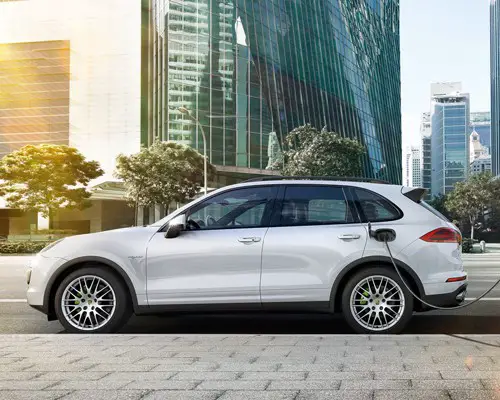
Five doors that are open to any adventure. With a dynamic design and efficient turbocharged engines. With outstanding digital connectivity that brings the whole world into the cockpit. With versatility, quality and cutting-edge assistance systems, offering both driver and passengers extraordinary comfort.This is how the Cayenne makes the Porsche experience even more fascinating, even more diverse. And yet remains what it has always been: a genuine sports car.
The electric motor produces 95 horsepower and 229 lb-ft of torque (41 horses and 66 lb-ft less than the motor in the 2018 Panamera Turbo S E-Hybrid). It’s fed by a 10.8-kWh lithium-ion battery pack, mounted under the cargo floor, that can be replenished from an optional on board 7.2-kW charger using a standard SAE J1772 connector or from Porsche’s own charging system that mounts on an owner’s garage wall. But when the battery’s charge drops to the point where the Cayenne must operate in hybrid mode, the performance slags off. In these situations, it needs 6.8 seconds to achieve 60 mph and getting to 100 mph takes 17.7 seconds.

Among the E-Hybrid’s many driving modes, the most interesting is the E-Power setting, which allows the vehicle to run solely on the electric motor at up to 78 mph. That’s 95 horsepower struggling against more than 2.5 tons. Porsche claims that the Cayenne E-Hybrid will reach 60 mph in 8.9 seconds running on electricity alone. The one significant difference between this Cayenne and the others is brake feel. The regenerative effect can be felt through the pedal and in how the SUV slows entering a corner. It’s something that the driver quickly acclimates to.

The E-Hybrid’s interior is five-passenger cozy rather than extravagant or expansive. The number of buttons on the dash and center console seems to be coming down, and the interior material quality seems to be going up. The infotainment has a total output of 1,455 watts, 21 individually controlled loudspeakers including an active sub woofer with 400-watt class D digital amplifier, two-way centre system and a total diaphragm surface area of more than 2,500 cm². All loudspeaker housings are perfectly matched and deliver superior bass foundation.The result is a natural and richly textured spatial sound, even at top volume. Particularly impressive is the new 3D sound experience, created by the loudspeakers integrated into the roof pillars and by the use of a special Auro 3D algorithm. The Sound Enhancer optimizes the quality of music in compressed data format. The system also blends impeccably into the overall interior aesthetic.
Safety features include
Adaptive cruise control (ACC) that helps depending on the distance from the vehicle ahead, the system controls the speed of your Cayenne completely independently. For this purpose, radar sensors in the front apron monitor the area in front of your vehicle.If you have set a certain speed and approach a vehicle that is driving more slowly, the system will reduce your speed by decelerating or gently braking until the pre-set distance is reached. Your Cayenne now maintains this distance from the vehicle in front. If this continues to brake, the adaptive cruise control reduces your speed.
Lane Keeping Assist including traffic sign recognition ; this system eases the burden on the driver by providing steering assistance, helping to keep the vehicle in lane.Integrated traffic sign recognition uses camera images and navigation data to detect speed limits, ‘no overtaking’ zones and to infer local traffic codes . Information is displayed in the instrument cluster.
Collision and brake assist :It reduces the risk of collision with cars, pedestrians or cyclists within the system limits.With the help of the front camera, the system detects an imminent collision with cars, pedestrians or cyclists and alerts the driver by means of a visual and acoustic warning. And possibly a brake jolt, if the vehicle approaches cars, pedestrians or cyclists too quickly. The driver’s own braking is then reinforced, down to a complete halt if necessary. If the driver fails to respond, an emergency stop is automatically initiated to avoid a collision or reduce its impact.
Night Vision Assist:
When driving at night, Night Vision Assist provides the driver with information even beyond the range of the headlights. An infrared camera detects pedestrians or larger animals before they are illuminated. In combination with PDLS Plus, the marker light function briefly flashes the headlight at the pedestrian on the pavement or in the carriageway three times to alert the driver.




